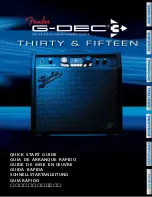
March 1994
6
Philips Semiconductors
Preliminary specification
Triple video output amplifier
TDA6103Q
Notes
1. See also Fig.6 for the typical low-frequency response of V
i
to V
oc
.
2. The ratio of the change in supply voltage to the change in input voltage when there is no change in output voltage.
t
s
settling time 50% input to
(99% < output < 101%)
V
oc(p-p)
= 100 V square
wave; f < 1 MHz;
t
r
= t
f
= 40 ns (pins 1, 2
and 3); see Figs 7 and 8
−
−
350
ns
SR
slew rate between
50 V to (V
DD
−
50 V); (pins 7, 8 and
9)
V
1
−
5
= V
2
−
5
= V
3
−
5
= 2 V
square wave (p-p);
f < 1 MHz; t
r
= t
f
= 40 ns
(pins 1, 2 and 3)
−
1600
−
V/
µ
s
O
v
cathode output voltage overshoot
(pins 7, 8 and 9)
V
oc(p-p)
= 100 V square
wave; f < 1 MHz;
t
r
= t
f
= 40 ns (pins 1, 2
and 3); see Figs 7 and 8
−
5
−
%
SVRR
supply voltage rejection ratio
f < 50 kHz; note 2
−
70
−
dB
SYMBOL
PARAMETER
CONDITIONS
MIN.
TYP.
MAX.
UNIT
Cathode output
The cathode output is protected against peak currents
(caused by positive voltage peaks during high-resistance
flash) of 5 A maximum with a charge content of 50
µ
C.
The cathode is also protected against peak currents
(caused by positive voltage peaks during low-resistance
flash) of 10 A maximum with a charge content of 100 nC.
The DC voltage of V
DD
(pin 6) must be within the operating
range of 180 to 210 V during the peak currents.
Flashover protection
The TDA6103Q incorporates protection diodes against
CRT flashover discharges that clamp the cathode output
voltage up to a maximum of V
DD
+ V
diode
. To limit the diode
current, an external 1.5 k
Ω
carbon high-voltage resistor in
series with the cathode output and a 2 kV spark gap are
needed (for this resistor-value, the CRT has to be
connected to the main PCB). This addition produces an
increase in the rise- and fall times of approximately 5 ns
and a decrease in the overshoot of approximately 3%.
V
DD
to GND must be decoupled:
1. With a capacitor >20 nF with good HF behaviour (e.g.
foil). This capacitance must be placed as close as
possible to pins 6 and 4, but definitely within 5 mm.
2. With a capacitor >10
µ
F on the picture tube base print.
Switch-off behaviour
The switch-off behaviour of the TDA6103Q is controllable.
This is due to the fact that the output pins of the
TDA6103Q are still under control of the input pins for
relative low-power supply voltages (approximately 30 V
and higher).

































